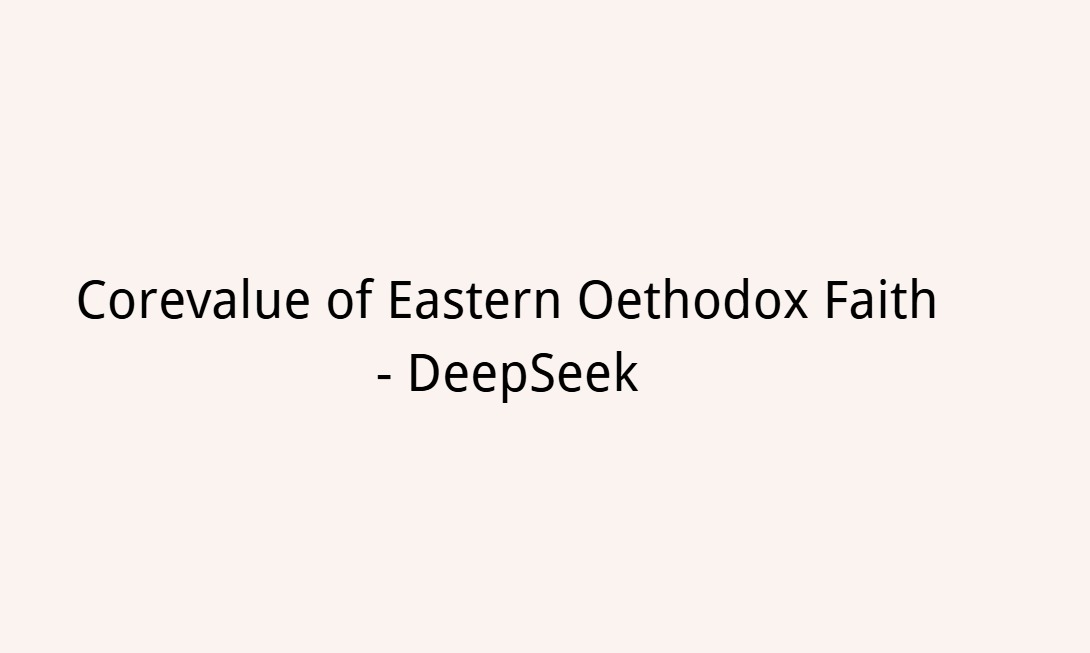Absolutely. Eastern Orthodoxy offers a profound and distinct expression of Christianity’s core values, deeply rooted in the early Church Fathers and the first seven Ecumenical Councils. Here’s an elaboration on how Orthodoxy embodies the enduring core:
**1. The Centrality of Jesus Christ: Deification (Theosis)**
* **Incarnation as Salvation:** Orthodoxy sees Christ’s incarnation itself as the pivotal act of salvation. By uniting divine and human natures in His person, He healed human nature, making it possible for humanity to participate in the divine life. “God became man so that man might become god” (St. Athanasius, *On the Incarnation*). This is **Theosis** – not becoming *ontologically* God, but participating in His divine energies, life, glory, and love, attaining likeness to God.
* **Resurrection as Victory:** Christ’s resurrection is the definitive victory over death (corruption, sin, Hades), transforming the very nature of existence. This victory is central to Orthodox hope and worship, especially Pascha (Easter).
* **Icon of the Father:** Christ is the perfect image (Icon) of the invisible Father (Col 1:15). Understanding God is centered on beholding Christ.
**2. Salvation by Grace through Faith: Synergy & Theosis**
* **Grace as Uncreated Energies:** Orthodox theology, particularly after St. Gregory Palamas (14th c.), distinguishes between God’s unknowable **Essence** and His knowable, active **Energies** (grace, light, power, love). Salvation comes through participation in God’s *uncreated energies*, not just an external legal declaration. Grace is God Himself acting upon and within creation.
* **Synergy (Cooperation):** Salvation is a divine-human **synergy**. God’s grace is absolutely primary and initiating, *but* it requires the free human response of faith, repentance, ascetic struggle, and participation in the sacramental life. Humans actively cooperate with divine grace. (Phil 2:12-13: “work out your own salvation with fear and trembling, for it is God who works in you…”).
* **Process of Theosis:** Salvation is viewed less as a one-time forensic event and more as a lifelong (and beyond) **process** of healing, transformation, and deification, enabled by grace and nurtured through the Church’s life.
**3. The Primacy of Love (Agape): Communion & Compassion**
* **God as Trinity: Communion of Love:** The fundamental revelation of God is the Holy Trinity – three Persons (Hypostases) united in perfect, self-giving love (perichoresis). Love is not just an attribute *of* God; God’s very being *is* eternal, loving communion. Human love reflects this divine pattern.
* **Agape Expressed as Compassion (Merciful Love):** Love for God and neighbor is paramount. This is expressed vividly as **compassion** (suffering-with) and active mercy towards all, especially the suffering and marginalized, seen as encountering Christ Himself (Matt 25:31-46). Philanthropy and acts of mercy are central Orthodox practices.
* **Asceticism as Love:** Ascetic practices (prayer, fasting, almsgiving) are not ends in themselves but tools for purification, freeing the heart from passions (selfish desires) to love God and neighbor more purely and selflessly. Love is the goal of asceticism.
**4. The Authority of Scripture: Within Holy Tradition**
* **Scripture *in* Tradition:** The Bible is the supreme written witness within the broader context of **Holy Tradition**. Tradition encompasses the lived experience of the Church: the decisions of Ecumenical Councils, the writings of the Fathers, the liturgical texts and practices, the lives of the Saints, and the guidance of the Holy Spirit. Scripture is interpreted authentically *within* this living, Spirit-guided Tradition.
* **Liturgical Scripture:** Scripture is encountered primarily *liturgically*. Large portions are read during services, and the entire liturgical cycle (hymns, prayers, icons) is saturated with scriptural imagery and theology. Scripture comes alive in worship.
**5. The Work of the Holy Spirit: Sanctification & Deification**
* **Sanctifier and Giver of Life:** The Holy Spirit is confessed as “the Lord, the Giver of Life” (Nicene Creed). The Spirit proceeds from the Father (rejecting the Filioque addition) and is the agent of sanctification, empowering believers for holiness, prayer, and the acquisition of virtues.
* **Chrismation:** The reception of the Holy Spirit is sacramentally sealed immediately after Baptism through **Chrismation** (Confirmation), anointing with Holy Chrism. This imparts the “seal of the gift of the Holy Spirit” and initiates the believer into the royal priesthood.
* **Hesychasm & The Uncreated Light:** Orthodox spirituality emphasizes inward prayer, particularly the **Jesus Prayer** (“Lord Jesus Christ, Son of God, have mercy on me, a sinner”), seeking stillness (hesychia) and purification of the heart. Advanced practitioners (Hesychasts) taught that through grace, purified believers could experience the **Uncreated Light** of God (seen at Christ’s Transfiguration) – a direct experience of God’s divine energies through the Holy Spirit.
**Distinctive Expressions & Emphasis:**
* **Sacraments (Holy Mysteries):** Seven primary sacraments are central channels of grace, especially the **Eucharist**, understood as the true Body and Blood of Christ, the ultimate medicine of immortality and foretaste of the Kingdom. Sacraments effect what they signify within the process of theosis.
* **The Church:** Understood as the **Body of Christ**, the visible and invisible community of the faithful across time, headed by Christ. It is the necessary context for salvation, Tradition, and the sacraments. Structure is conciliar (councils) and episcopal, with Patriarchs and autocephalous churches.
* **Icons:** Not mere art, but **theological windows** to the divine. Based on the Incarnation (the visible image of the invisible God), icons affirm Christ’s true humanity, venerate the Saints who reflect His image, and facilitate prayerful communion. The 7th Ecumenical Council (787 AD) defended their use against Iconoclasm.
* **Mary (Theotokos):** Venerated as the “God-bearer” (Theotokos), whose “Yes” (Luke 1:38) made the Incarnation possible. She is the supreme example of theosis and human cooperation with grace.
* **Eschatology:** Focuses on the final victory of Christ, the resurrection of the body, and the ultimate fulfillment of theosis in the Kingdom of God. The state after death is often described as a foretaste of the final judgment and resurrection.
**In Summary:**
Eastern Orthodoxy holds firmly to the universal Christian core centered on Christ, grace, love, Scripture, and the Spirit. Its unique emphasis lies in:
* **Theosis** as the goal of salvation (participation in divine life).
* **Synergy** between God’s uncreated energies and human freedom.
* The Holy Trinity as the model of **communion**.
* Scripture interpreted within the fullness of **Holy Tradition**.
* The **Sacraments** (especially the Eucharist) as essential means of grace and deification.
* **Experiential Spirituality** (Hesychasm, Uncreated Light) through the Holy Spirit.
* **Liturgy** as the primary context for encountering God and Scripture.
This rich tradition maintains an unbroken continuity with the faith and practice of the early undivided Church, offering a deeply mystical and sacramental path centered on transforming communion with the Triune God.




